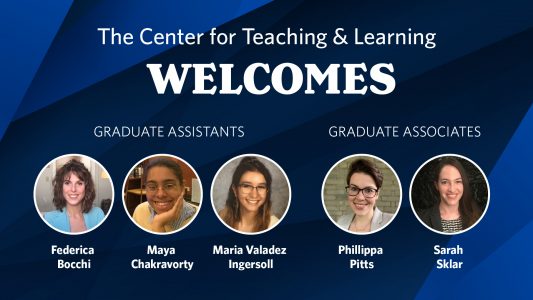Welcome to the Graduate Teaching Blog!

This blog is a space created for graduate students, by graduate students, for us to share answers to common teaching questions. In these pages, you will find suggestions for innovative, evidence-based teaching strategies presented in the context of our own graduate teaching experiences. We hope these posts enrich your teaching practice!

Some thoughts on English grammar assessment from a non-native speaker
Contributed by Federica Bocchi, PhD Candidate in Philosophy of Science (5-minute read) In her previous blog post, Maya discussed the tension between recognizing the importance of grammatical accuracy in writing assignments and acknowledging the disadvantages this practice could induce, especially in non-native English speakers. As a multilingual learner and instructor, I would... More

Fostering Intrinsic Motivation In Introductory Classes
Fostering students’ motivation to learn is complicated in intro classes with a highly heterogeneous demographic. Learn ways to foster your student's intrinsic motivation.
(Contributed by Federica Bocchi.)
More
Using Self-Explanation in an Introductory Biology Lab
Explores how to implement self-explanation to enable students to apply theories they have learned in lecture to the living biological world.
(Contributed by Maria Valadez Ingersoll.)
More
Self Explanation Exercise in Philosophy
An example of a self-explanation exercise used in a philosophy course shows how self-explanation is a useful pedagogical technique.
(Contributed by Federica Bocchi.)
More
Introduction to Self-Explanation
Learn how educators can encourage contextualized learning over memorization of steps with the process of self-explanation.
(Contributed by Maria Valadez Ingersoll.)
More
CTL’s Graduate Assistants and Associates
This semester, five wonderful graduate students are helping the CTL to provide support to the graduate student teaching community at BU. Graduate Assistants Federica Bocchi (Philosophy), Maya Chakravorty (Classical Studies), and Maria Valadez Ingersoll (Cellular and Molecular Biology) joined us this month, and Graduate Associates Phillippa Pitts (History of Art... More

Including Diverse Role Models in STEM Curricula
Including Diverse Role Models in STEM Curricula Contributed by Bryanne McDonough In most areas of the STEM workforce, racial minorities, people with disabilities, and women are still underrepresented [1,2]. As college educators, we have a critical role to play in retaining and encouraging underrepresented students in STEM. One way to accomplish this... More

Keeping Breakout Rooms On Task
Contributed by Phillippa Pitts (2 minute read) Research shows that assigning students to work in small groups can enhance learning (and introduce variety, which can help reenergize a long summer term class!), but how can you structure the activity to keep students engaged and on task? In our Graduate Student Teaching blog, More

Jump-starting Discussion Using Images (Part 2)
Graduate Teaching Blog Post Contributed by Phillippa Pitts (5 minute read) This post is a follow-up to my entry last week, where I introduced two quick approaches to teaching with images in ways that will get students talking and thinking about your course content in a new way. In this post, I’d... More

Jump-starting Discussion Using Images
Graduate Teaching Blog Post Contributed by Phillippa Pitts (5 minute read) Q:I've heard that starting class by asking students to discuss an image can help get students talking, even in a non-arts based course. What are your suggestions for teaching with images? A: In almost every conversation that I’ve heard about “opening up... More